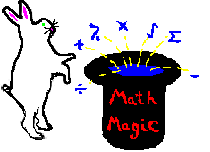 |
||
| HOME
Miscellaneous Elementary Junior High Sum Of Positive Integral Divisors High School Manipulating Polygonal Numbers
|
Cube Roots:A. Working with cube roots is very similar to working with square roots. 1. By looking at the last number, we can determine the last digit of the answer. If the last number ends in: 0 -> the last digit ends in 0. 1 -> the last digit ends in 1. 2 -> the last digit ends in 8. 3 -> the last digit ends in 7. 4 -> the last digit ends in 4. 5 -> the last digit ends in 5. 6 -> the last digit ends in 6. 7 -> the last digit ends in 3. 8 -> the last digit ends in 2. 9 -> the last digit ends in 9. 2. Once the last digit is determined, write it down and mentally chop off the last 3 digits under the cube root. 3. Using your knowledge of cubes, find what numbers the remaining are between. Write the smallest of these numbers. Ex [1] 3/(373248) = __________. a. We know the last digit ends in a 2. Write 2. b. Chopping off the last 3 numbers we are left with 373. c. We know that 73 = 343 and 83 = 512, so the first digit is 7. Write 7. d. The answer is 72. Ex [2] 3/(1601613) = __________. a. We know that the last digit is 7. Write 7. b. Chopping off the last 3 digits we are left with 1601. c. We know that 113 = 1331 and 123 = 1728, so the first digits are 11. Write 11. d. The answer is 117.
|
